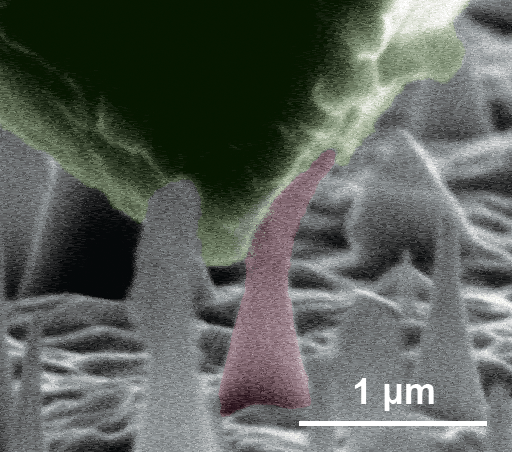A team of physicists has figured out how to bend diamonds, according to a new paper. OK, we’re talking about nano-scale diamond needles here. But it’s an impressive feat, because while diamonds are known for their hardness, these rocks will break if they are bent even a tiny bit.
In a new experiment, engineers managed to create tiny diamond “needles” that can bend back and forth without snapping.
“We were excited to see how much these nano-needles could bend and stretch,” study author Ming Dao from MIT told Gizmodo. “This much elastic deformation is a surprise to many people.”

A bending diamond. Image: Ming Dao (MIT)
The researchers etched the diamonds into little needles, each a little over two micrometres (2000 nanometres) tall, on a silicon surface, and confirmed they really were diamonds using an electron microscope. They used a larger diamond indenter to push the tip of the needle as far as 442 nanometres horizontally, and watched as the needles returned to their original position. They tried to push them even further and watched the needles snap once the tip had been moved 464 nanometres. The results of the work are published today in Science.
Why didn’t the diamond snap? Dao explained that smaller is stronger when it comes to bending, proportionally. Additionally, the nano-needles don’t have any defects which could make them more brittle; it’s more difficult to avoid defects in larger objects’ structures.
“When materials are made at the nanoscale, they have incredibly interesting and unique properties compared to bulk materials of the same composition,” Heidi Culver, postdoctoral associate not involved in the study who researches materials science at the University of Colorado, Boulder, told Gizmodo. In other words, while these nano-diamonds are just as much real diamonds as the kind we wear in jewellery, they have different traits that only seem the show up on these small scales.
Now that we know about the flexibility, Dao’s paper lists a host of potential applications for the nano-needles, including using them to store data or to deliver drugs directly into cells, or simply as ultra-strong nanostructures. Before that, he and his team still hope to measure whether the chemical properties of the diamonds change under the stress.
Mostly, it’s just cool. Said Dao: “It was definitely a surprise.”
[Science]
